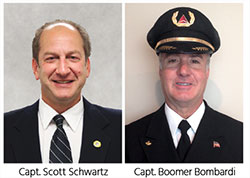Remember Your Training: An Inflight Fire Refresher
By Capt. Scott Schwartz (FedEx Express), Director, ALPA Dangerous Goods Program, and Capt. Boomer Bombardi (Delta), Subject-Matter Expert, ALPA Aircraft Design and Operations Group

By now, you’ve probably read about the Hawaiian Airlines flight incident where a passenger’s e-cigarette caught fire in the checked baggage compartment, melting a plastic suitcase and putting the crew through an inflight fire emergency landing.
While the crew did a great job of getting the airplane on the ground safely, it’s a reminder that these ubiquitous devices still pose a risk to aviation safety in the form of inflight fires, which if not properly addressed, could be on the rise.
As ALPA continues to advocate for policies and regulations to ensure the safe air transport of lithium batteries in our aircraft—whether in a passenger’s checked or carry-on bag, in devices being transported as cargo, or in shipments packed for bulk delivery—we must remain vigilant. This means knowing exactly what to do during an inflight fire, since in many cases, the halon fire-suppression systems on our aircraft cannot extinguish a lithium battery fire that burns too hot and too fast to control.
While every pilot hopes never to face an inflight fire outside of the simulator, as a crewmember, you should always be prepared to handle the situation. Following your equipment’s emergency checklist and procedures is paramount, and timing is critical. What you do in the first few moments of an inflight fire can be the determining safety factor for your flight. As ALPA’s subject-matter experts on this issue, we’re providing a quick refresher on inflight fire procedures.
Read: Know what’s in your cargo—review the cargo manifests, walk through the cargo hold, and/or watch the crew load the cargo onto the aircraft. Since many compliant shipments aren’t identified to crews, seeing hazardous materials, or their labeling, being placed on board your aircraft can help prompt the “mental switch.”
Recognize: When you first detect an inflight fire, it often is signaled by an out-of-place odor or smoke/fire warning. While you could easily dismiss it, don your oxygen mask to shave valuable seconds in response time and to protect yourself from fumes. The adage “better safe than sorry” applies—practice in the simulator while donning oxygen, and make sure you’re able to do everything required of you.
React: Keep the appropriate checklists for handling an inflight fire handy and know your memory items. Practice your flows, know your cockpit so well that you can identify exits blindfolded. React per your training, and above all, know the location of and how to use all the resources—people, information, and equipment—to manage the response. Don’t hesitate to put barriers between you and the fire’s source—like a closed cockpit door or smoke curtain. Never forget to aviate, navigate, and then communicate.
Return: In the event of an inflight fire, find a suitable airport right away. You’ll also need to manage your altitude and airspeed to ensure a stable approach and a safe landing, as a stabilized approach is key to avoiding a long landing or a go-around.
Rescue and Response: Clearly communicate with ATC “inflight fire.” Set yourself up for success by having airport rescue and firefighting equipment in place upon your arrival on the ground.
Thankfully, inflight fires are a rarity; but as airline pilots, we must remain vigilant and always be ready to put our training to use so that we can continue to keep air travel safe for all.
Acknowledgement: We’d like to thank Capt. Shem Malmquist (FedEx Express) for his insights on this important topic.

